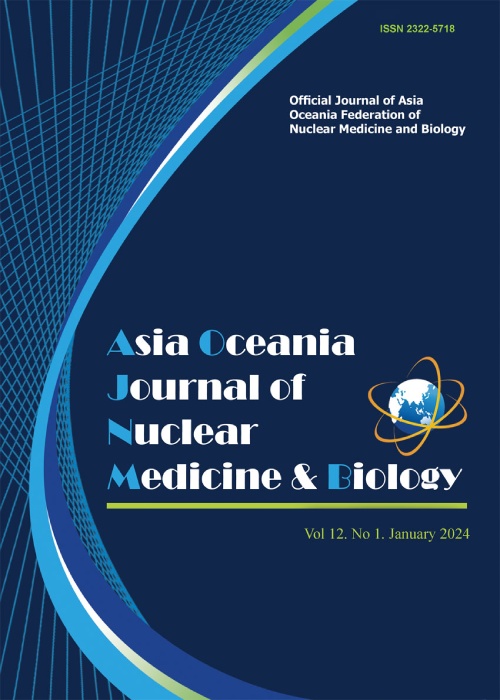Both F-18 FDG-avidity and Malignant Shape of Cervical Lymph Nodes on PET/CT after Total Thyroidectomy Predict Resistance to High-dose I-131 Therapy in Patients with Papillary Thyroid Cancer
Author(s):
Byung Hyun Byun , Seong Young Kwon , Ari Chong , Jahae Kim , Su Woong Yoo , Jung , Joon Min , Ho , Chun Song , Henry Hee , Seung Bom
Abstract:
Objective
Resistance of metastatic lymph nodes (LNs) to high dose I-131 therapy is associated with high morbidity in patients with differentiated thyroid cancer. We evaluated the role of F-18 FDG PET/CT in the prediction of resistance to high dose I-131 therapy in patients with papillary thyroid cancer. Methods
The subjects were 307 patients who underwent total or near total thyroidectomy followed by high dose (5.55-6.66 GBq) I-131 therapy. We divided the patients into three subgroups by visual assessment of regional LNs: FDG-avid LNs with a malignant shape on CT (PET/CT-positive group), FDG-avid LNs with a benign shape on CT (PET/CT-intermediate group) and no FDG-avid lesion (PET/CT-negative group). We measured the maximum SUV (SUVmax) of FDG-avid LNs in each patient. The presence or absence of focal increased uptake of I-131 was evaluated by whole body scan (WBS), and was denoted as WBS-positive group or WBS-negative group, respectively. Resistance to therapy was defined as presence of thyroglobulin (Tg) in serum (Tg ≥1.0 ng/ml) 3-6 months after I-131 therapy. Univariate and multivariate analyses were performed to determine the relationship between resistance to I-131 therapy and various clinico-pathologic variables. Results
PET/CT-positive, intermediate, and negative groups included 20 (6.5%), 44 (14.3%) and 243 (79.2%) patients, respectively. The mean SUVmax was significantly higher in the PET/CT-positive group than that of the PET/CT-intermediate group (4.6 vs. 2.7, P <0.001). Univariate analysis revealed that the PET/CT-positive group (P <0.001), T2-4 stage (P <0.001), N1b stage (P = 0.001), lower dose (5.55 GBq) of I-131 (P <0.001), and the WBS-positive group (P = 0.029) were associated with resistance to therapy. In multivariate analysis, the PET/CT-positive group, lower dose of I-131, N1b stage, and T2-4 stage remained significant with odds ratios of 10.07 (P <0.001), 3.82 (P <0.001), 3.58 (P = 0.001), and 2.53 (P = 0.009), respectively. Conclusion
FDG-avidity and malignant shape of cervical LNs on pre-therapy FDG PET/CT were a strong risk factors predicting resistance to high dose I-131 therapy. A lower dose of administered I-131 (5.55 GBq) and more extensive tumors (T2-4 and N1b) were also associated with resistance to high dose I-131 therapy.Keywords:
Language:
English
Published:
Asia Oceania Journal of Nuclear Medicine & Biology, Volume:1 Issue: 1, Winter 2013
Page:
6
magiran.com/p1128187
دانلود و مطالعه متن این مقاله با یکی از روشهای زیر امکان پذیر است:
اشتراک شخصی
با عضویت و پرداخت آنلاین حق اشتراک یکساله به مبلغ 1,390,000ريال میتوانید 70 عنوان مطلب دانلود کنید!
اشتراک سازمانی
به کتابخانه دانشگاه یا محل کار خود پیشنهاد کنید تا اشتراک سازمانی این پایگاه را برای دسترسی نامحدود همه کاربران به متن مطالب تهیه نمایند!
توجه!
- حق عضویت دریافتی صرف حمایت از نشریات عضو و نگهداری، تکمیل و توسعه مگیران میشود.
- پرداخت حق اشتراک و دانلود مقالات اجازه بازنشر آن در سایر رسانههای چاپی و دیجیتال را به کاربر نمیدهد.
In order to view content subscription is required
Personal subscription
Subscribe magiran.com for 70 € euros via PayPal and download 70 articles during a year.
Organization subscription
Please contact us to subscribe your university or library for unlimited access!


